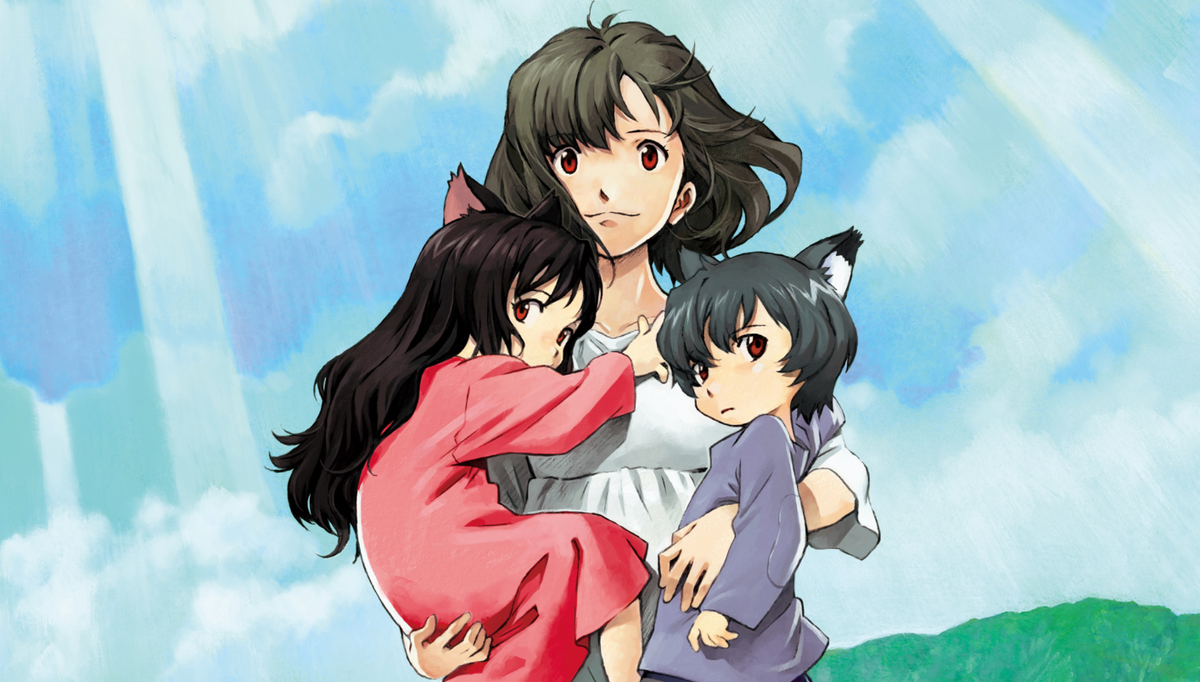Thomas Caffrey sinks his teeth into classic anime with this review of Wolf Children.
Mamoru Hosoda’s anime classic Wolf Children is, ironically, not like a wolf: it never bites off more than it can chew. Instead, it is a subtle masterpiece that luxuriates in small moments of quiet character development. The film is a joy in every sense; it is visually splendid, subtly (but powerfully) written, and evocatively acted.
Wolf Children (written by Hosoda and frequent collaborator Satoko Okudera) takes the form of a fairy tale-esque story. It begins with a young college student named Hana falling in love. Her new boyfriend is a werewolf, but not of the silver-bullet and full-moon massacre sort. This werewolf can shift between forms at will, possesses a measure of self-control in wolf form, and hunts wild pheasants to support his wife – and shortly thereafter, their two half-wolf children, Yuki (the name means ‘snow’, referring to the snowfall that accompanied her birth) and Ame (meaning ‘rain’, referring to the storms at his birth). When Hana’s partner unexpectedly dies, she is left to raise two werewolf children on her own, with no guidance or precedent for the task. Wolf children, after all, cause all sorts of mischief.
The film that follows this setup walks a fine line: it manages to be both truly funny and introspective. This is best seen in the film’s central conflict, which emerges as a push-pull problematic around the children’s identity: are they wolves or are they humans? Do they belong in human society or in the wild mountains of Japan? This tension is felt at first through comedy; when Yuki eats a dishwasher tablet, Hana runs to the nearest hospital. However, opposite the hospital on the same street, she sees a vet and is suddenly torn – would her daughter benefit from a vet or a doctor? She ends up consulting both, frantically, over a payphone. Later, Hana is in trouble with her landlords, whose no-pets policy is challenged by howling wolflings. These scenes are genuinely hilarious, impeccable in their direction and editing.
As the film progresses, however, a more sombre tone emerges. The film does not abandon comedy, and thankfully never fully sheds its light-hearted surface, but Hosoda introduces a sort of dramatic gravity; the children’s ultimate fate will be decided by the end of the film. They must choose where they belong: the world of humanity or the world of the wild. Hosoda and Okudera mine this central werewolf theme for nearly all its possible metaphoric meanings. The werewolf condition stands in for grief, puberty, and perhaps most effectively, for human stewardship over nature, when Ame begins to meet with a wise mountain fox. The idea of ecological stewardship is introduced rather late in the film, and one feels that if Wolf Children were an anime mini-series, this strand could have been afforded more time and development. But this is a minor complaint: Hosoda never overcomplicates the werewolf condition. It is left wisely vague.
Thirteen years on, Wolf Children still represents the pinnacle of anime filmmaking. In particular, Yoshiyuki Sadamoto’s distinctive character designs shine; the wolf forms of each character look distinctive and recognisable, while retaining a beast-like quality. Sadamoto, best known for his work on Neon Genesis Evangelion and that series’ various evolutions, has a unique art style that Hosoda’s team at Studio Chizu ably replicates. The result is a cast of simply designed and wonderfully emotive characters. Little touches abound too: when Hana moves to the countryside and works at tilling fields, she picks up an at-first subtle tan that deepens as the years pass.
The animation in Wolf Children is impressive. Fluid and crisp, the film blends traditional 2D animation with sparingly used 3D animation. This combination adds a sense of naturalism to the wild mountain environments that Hana and her family move to. This year’s 4K restoration is a revelation, providing an all-new clarity that makes the film’s world feel even more tangible and immersive. In several sequences, where the wolves let loose and run wild among the rocks, snow and trees, the film achieves a propulsive and joyful sense of overload.
The emotional peaks are not only of joy; Wolf Children is sometimes dark and never shies away from the mortality of its characters, referring early on to the extinction of the Japanese wolf. When Hana’s partner dies, the moment of his discovery is nakedly heartrending. But this does not make the film unsuitable for family viewing: the healing and character development following such moments are essential. This is a family film in the truest sense – it has the ability to speak on heavy subject matter to (and for) parents, caregivers and children alike. Through music, animation, and clever directional choices (for example, when a character’s transformation between wolf and girl is artfully masked by fluttering curtains), Wolf Children maintains a heightened and powerful emotional register.
It is often tempting to compare breakthrough anime films to Studio Ghibli or Makoto Shinkai, but Wolf Children has a completely different cadence. It is a laid-back film, with little in the way of immediate peril. Rather, any tension felt in Wolf Children is the recognisable tension of growing up, of arguing with parents, and of schoolyard scuffles: the film has no villains or world-ending stakes. It is, instead, a beautiful and deceptively simple story that manages to speak to the passage of youth, the pains of single parenthood, and the environmental crisis of the modern age. It is a uniquely naturalistic anime film and ends on a satisfying compromise, rich with emotional complexity.
Wolf Children is available to stream online now.

